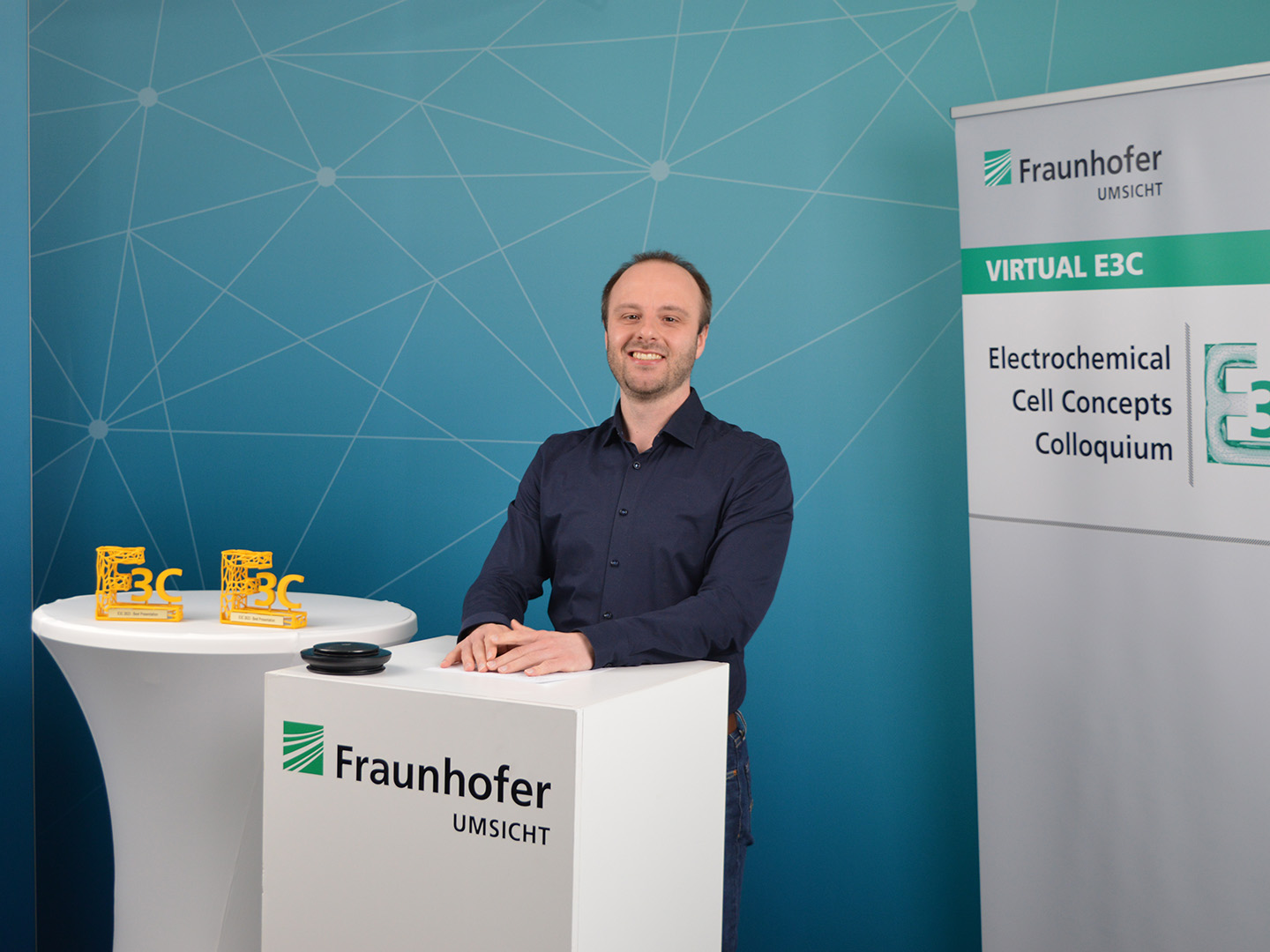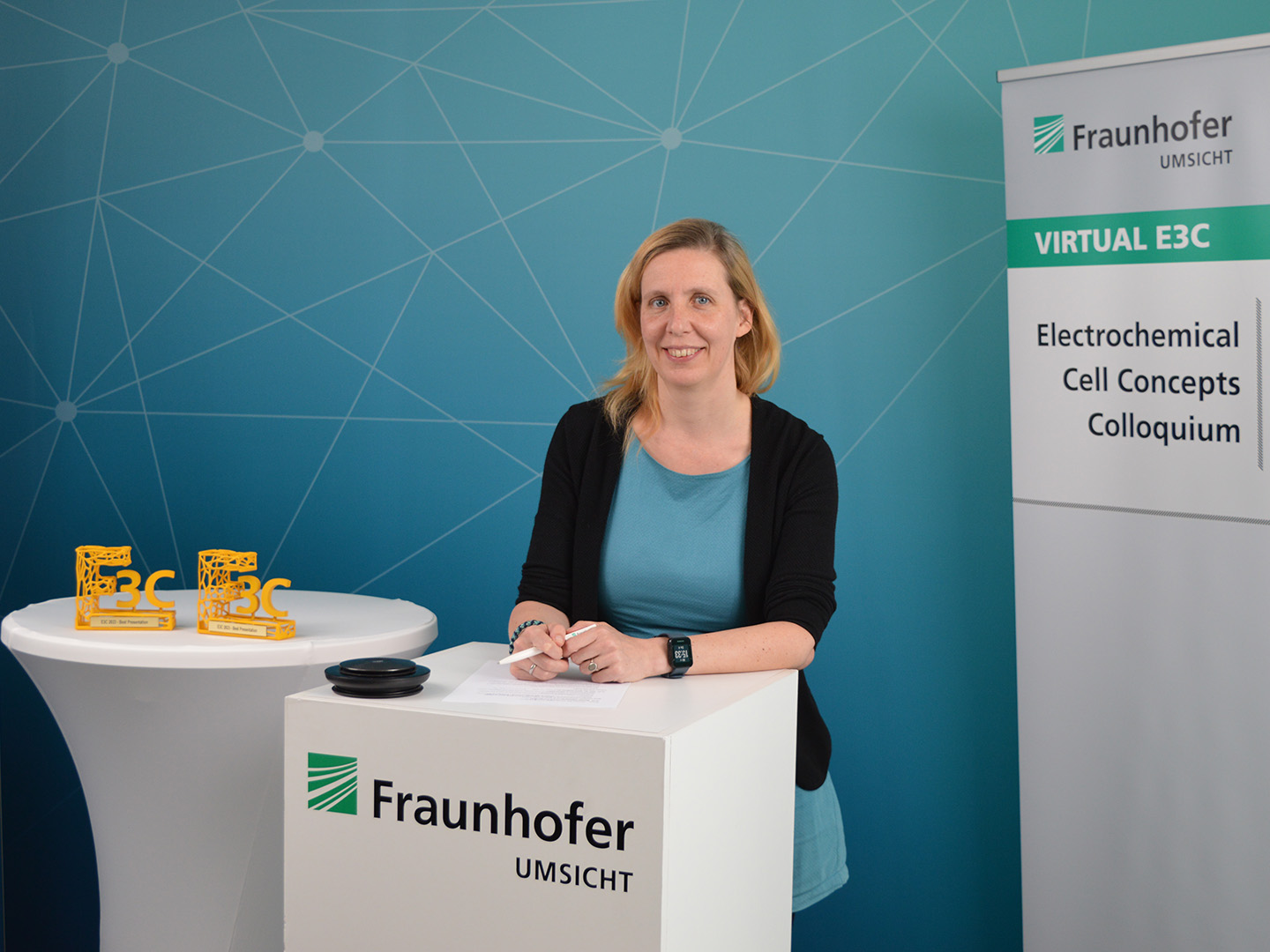Design of electrochemical reactors
Fourth "Electrochemical Cell Concepts Colloquium – E3C" revolved around electrodes (modifications) and flow guidance in electrochemical reactors
Fourth edition, slightly changed format: This year's "Electrochemical Cell Concepts Colloquium – E3C" spanned two afternoons for the first time. On May 4 and 5, 2023, scientists from Germany, Belgium, Poland, Spain, Canada and the USA provided insights into their research. The virtual event focused on electrodes and electrode modifications as well as flow guidance in electrochemical reactors such as fuel cells, flow batteries or electrolyzers.


Sustainable production of bipolar plates for fuel cells
Dr. Marco Grundler from the Hydrogen and Fuel Cell Center ZBT in Duisburg provided the introduction to the topic. The scientist focused his keynote on bipolar plates for PEM fuel cells, addressing functions and requirements as well as design features and material classification. He paid particular attention to three projects for the sustainable production of bipolar plates from polymer compounds. His conclusion: "The use of bio-based plastics and natural graphites for fuel cell applications is possible, as is the use of recycled materials."
Electrolysis cell design
The next three presentations revolved around various approaches to the design of electrolysis cells. Dr. Carsten Pietzka from Fraunhofer IGB presented research work from the Fraunhofer lead project "ShaPID – Shaping the Future of Green Chemistry by Process Intensification and Digitalization". Specifically, he compared two cell configurations for different process options: electrocatalytic formate production with liquid catholyte and a zero-gap cell for formic acid production.
Frank Gillung explained how a zero-gap design can be used to overcome weaknesses in classic alkaline water electrolysis such as ohmic losses and bubble formation. The scientist from the Brandenburg University of Technology Cottbus-Senftenberg spoke about the use of 3D electrodes and Zirfon® membranes, among other things.
Limitations of a cathode-centered view on hydrogenation reactions were shown by Jonas Wolf from Fraunhofer UMSICHT. His alternative approach: make changes to the anodes – focusing on (porous) transport material, membranes and the configuration of membrane-electrode units. In this way, an optimization of the electrode cell and the process parameters could be achieved, according to the scientist.
Redesign flow fields
In the second session of the first day, Monika Jalowiecka (Warsaw University of Technology) and Prof. Dr. Jasna Jankovic (University of Connecticut) presented new approaches to the design of flow fields, also called flow fields. For example, Monika Jalowiecka reported on improvements in mass transport within a formic acid fuel cell using a duct design with a rectangular trapezoidal baffle.
Jasna Jankovic and her research group, on the other hand, had taken inspiration from nature in designing flow fields. "Our tube design applied to plants brings many potential benefits," she summarized. "Starting with low material costs for the components, to more efficient gas distribution, to 50 percent higher energy density."
Minimize losses in the reactor
The second day of the colloquium also opened with the topics of flow fields and fluid flow: In his keynote address, Prof. Dr. Jonas Hereijgers from the University of Antwerp explored the question of how electrochemical flow reactors can be designed and oscillated. The overall goal of this approach: to minimize ohmic, transport and activation losses in the reactor. "One finding of our work so far is that oscillating pulses result in bubbles not blocking surfaces," the scientist explained. "This can already significantly reduce losses."
A 3D-printed biomimetic flow field for improving electrochemical mass transfer was presented by Inmaculada Garcia Lopez from the Complutense University in Madrid. This flow field - according to the scientist – not only brings the advantage of fast manufacturing, but at the same time increases the limiting current value by an average of 75.8 to 91 percent compared to conventional geometries.
Lukas Siefert from the University of Duisburg-Essen then compared the investigation results of CFD simulations and electrochemical experiments of flow fields in a 250 cm² zinc-polyiodide hybrid flow battery.
From bladder and fluid management
In the last session of the event, the focus switched back to electrodes. For example, Prof. Miguel A. Modestino from New York University addressed the influence of bubble formation on the energy conversion efficiency of electrochemical reactors in his keynote. "Gas bubbles reduce the actual active electrode area, leading to energy losses," he pointed out. "But still too little is known about the process of bubble formation and the electrochemical phenomena surrounding it." His team and he are therefore looking at different strategies for dealing with gas bubbles to further optimize electrochemical reactions.
Laura Huwald and Maximilian Wand from Fraunhofer UMSICHT presented laser ablation and microstructuring of bipolar plates for PEM fuel cells in their talk. Laser ablation, for example, increases the conductivity and hydrophobicity of a composite bipolar plate, while microstructuring improves fluid management, the two researchers emphasized.
The fourth "Electrochemical Cell Concepts Colloquium – E3C" concluded with a contribution by Caio Vinicios Juvêncio da Silva. The scientist from Simon Fraser University in Vancouver reported on electrode modifications for vanadium flow batteries. His conclusion was that "battery performance is primarily influenced by improving wettability and thus increasing the electrochemically useful electrode surface area. This in turn leads to an improvement in electrode kinetics."
As in the previous year, the E3C Award for the best presentation was also presented in 2023. This year it went – based on a vote among the approximately 80 participants of the event – to Marco Grundler (event day 1) and Miguel A. Modestino (event day 2). Those who missed the contributions will have the opportunity to gain insight during the course of the year: The publication of an open access conference volume is planned.
Last modified:
 Fraunhofer Institute for Environmental, Safety and Energy Technology UMSICHT
Fraunhofer Institute for Environmental, Safety and Energy Technology UMSICHT








